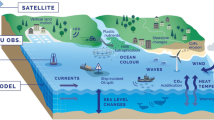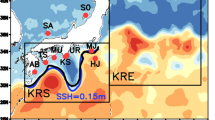Abstract
Sensitive areas for prediction of the Kuroshio large meander using a 1.5-layer, shallow-water ocean model were investigated using the conditional nonlinear optimal perturbation (CNOP) and first singular vector (FSV) methods. A series of sensitivity experiments were designed to test the sensitivity of sensitive areas within the numerical model. The following results were obtained: (1) the eff ect of initial CNOP and FSV patterns in their sensitive areas is greater than that of the same patterns in randomly selected areas, with the eff ect of the initial CNOP patterns in CNOP sensitive areas being the greatest; (2) both CNOP- and FSV-type initial errors grow more quickly than random errors; (3) the eff ect of random errors superimposed on the sensitive areas is greater than that of random errors introduced into randomly selected areas, and initial errors in the CNOP sensitive areas have greater eff ects on final forecasts. These results reveal that the sensitive areas determined using the CNOP are more sensitive than those of FSV and other randomly selected areas. In addition, ideal hindcasting experiments were conducted to examine the validity of the sensitive areas. The results indicate that reduction (or elimination) of CNOP-type errors in CNOP sensitive areas at the initial time has a greater forecast benefit than the reduction (or elimination) of FSV-type errors in FSV sensitive areas. These results suggest that the CNOP method is suitable for determining sensitive areas in the prediction of the Kuroshio large-meander path.
Similar content being viewed by others
References
Baker N L, Daley R. 2000. Observation and background adjoint sensitivity in the adaptive observation-targeting problem. Quart. J. Roy. Meteor. Soc., 126 (565): 1431–1454.
Bergot T, Hello G, Joly A, Malardel S. 1999. Adaptive observations: a feasibility study. Mon. Wea. Rev., 127 (5): 743–765.
Berliner L M, Lu Z Q, Snyder C. 1999. Statistical design for adaptive weather observations. J. Atmos. Sci., 56 (15): 2536–2552.
Birgin E G, Martínez J M, Raydan M. 2000. Nonmonotone spectral projected gradient methods on convex sets. SIAM J. Optim., 10 (4): 1196–1211.
Bishop C H, Etherton B J, Majumdar S J. 2001. Adaptive sampling with the ensemble transform Kalman filter. Part I: theoretical aspects. Mon. Wea. Rev., 129 (3): 420–436.
Bishop C H, Toth Z. 1999. Ensemble transformation and adaptive observations. J. Atmos. Sci., 56 (11): 1748–1765.
Buizza R, Montani A. 1999. Targeting observations using singular vectors. J. Atmos. Sci., 56 (17): 2965–2985.
Ebuchi N, Hanawa K. 2000. Mesoscale eddies observed by TOLEX-ADCP and TOPEX/POSEIDON altimeter in the Kuroshio recirculation region south of Japan. J. Oceanogr., 56 (1): 43–57.
Ebuchi N, Hanawa K. 2003. Influence of mesoscale eddies on variations of the Kuroshio path south of Japan. J. Oceanogr., 59(1): 25–36.
Fujii Y, Tsujino H, Usui N, Nakano H, Kamachi M. 2008. Application of singular vector analysis to the Kuroshio large meander. J. Geophys. Res., 113(C7): C07026, http://dx.doi.org/10.1029/2007JC004476.
Hamill T M, Snyder C. 2002. Using improved backgrounderror covariances from an ensemble kalman filter for adaptive observations. Mon. Wea. Rev., 130(6): 1552–1572.
Hellerman S, Rosenstein M. 1983. Normal monthly wind stress over the world ocean with error estimates. J. Phys. Oceanogr., 13(7): 1093–1104.
Ishikawa Y, Awaji T, Komori N, Toyoda T. 2004. Application of sensitivity analysis using an adjoint model for shortrange forecasts of the Kuroshio path south of Japan. J. Oceanogr., 60(2): 293–301.
Kawabe M. 1995. Variations of current path, velocity, and volume transport of the Kuroshio in relation with the large meander. J. Phys. Oceanogr., 25(12): 3103–3117.
Langland R H, Rohaly G D. 1996). Adjoint-based targeting of observations for FASTEX cyclones. In: Proceedings of the Seventh Conference on Mesoscale Processes, Reading. Amer. Meteor. Soc., United Kingdom. p.369–371.
Langland R H. 2005. Issues in targeted observing. Quart. J. Roy. Meteor. Soc., 131(613): 3409–3425.
Majumdar S J, Aberson S D, Bishop C H, Buizza R, Peng M S, Reynolds C A. 2006. A comparison of adaptive observing guidance for Atlantic tropical cyclones. Mon. Wea. Rev., 134(9): 2354–2372.
Mitsudera H, Waseda T, Yoshikawa Y, Taguchi B. 2001. Anticyclonic eddies and Kuroshio meander formation. Geophys. Res. Lett., 28(10): 2025–2028.
Miyazawa Y, Guo X Y, Yamagata T. 2004. Roles of mesoscale eddies in the kuroshio paths. J. Phys. Oceanogr., 34(10): 2203–2222.
Miyazawa Y, Kagimoto T, Guo X Y, Sakuma H. 2008. The Kuroshio large meander formation in 2004 analyzed by an eddy-resolving ocean forecast system. J. Geophys. Res., 113(C10): C10015.
Miyazawa Y, Yamane S, Guo X Y, Yamagata T. 2005. Ensemble forecast of the Kuroshio meandering. J. Geophys. Res., 110(C10): C10026, http://dx.doi.org/10.1029/2004JC002426.
Morss R E, Emanuel K A, Snyder C. 2001. Idealized adaptive observation strategies for improving numerical weather prediction. J. Atmos. Sci., 58(2): 210–232.
Mu M, Duan W S, Wang B. 2003. Conditional nonlinear optimal perturbation and its applications. Nonlinear Process es in Geophys ics, 10(6): 493–501.
Mu M, Wang H L, Zhou F F. 2007. A preliminary application of conditional nonlinear optimal perturbation to adaptive observation. Chin. J. Atmos. Sci., 31(6): 1102–1112. (in Chinese)
Mu M, Zhou F F, Wang H L. 2009. A method for identifying the sensitive areas in targeted observations for tropical cyclone prediction: conditional nonlinear optimal perturbation. Mon. Wea. Rev., 137(5): 1623–1639.
Mu M. 2013. Methods, current status, and prospect of targeted observation. Science China Earth Sciences, 56(12): 1997–2005.
Palmer T N, Gelaro R, Barkmeijer J, Buizza R. 1998. Singular vectors, metrics, and adaptive observations. J. Atmos. Sci., 55(4): 633–653.
Pu Z X, Kalnay E, Sela J, Szunyogh I. 1997. Sensitivity of forecast errors to initial conditions with a quasi-inverse linear method. Mon. Wea. Rev., 125(10): 2479–2503.
Pu Z X, Kalnay E. 1999. Targeting observations with the quasi-inverse linear and adjoint NCEP global models: performance during FASTEX. Quart. J. Roy. Meteor. Soc., 125(561): 3329–3337.
Qin X H, Mu M. 2011. A study on the reduction of forecast error variance by three adaptive observation approaches for tropical cyclone prediction. Mon. Wea. Rev., 139(7): 2218–2232.
Qiu B, Miao W F. 2000. Kuroshio path variations south of Japan: bimodality as a self-sustained internal oscillation. J. Phys. Oceanogr., 30(8): 2124–2137.
Taft B A. 1972. Characteristics of the flow of the Kuroshio south of Japan. In: Stommel H, Yoshida K eds. Kuroshio: Its Physical Aspects. University of Tokyo Press, Tokyo. p.165–216.
Tsujino H, Usui N, Nakano H. 2006. Dynamics of Kuroshio path variations in a high-resolution general circulation model. J. Geophys. Res., 111(C11): C11001, http://dx.doi. org/10.1029/2005JC003118.
Usui N, Tsujino H, Nakano H, Fujii Y. 2008. Formation process of the Kuroshio large meander i. 2004. J. Geophys. Res., 113(C8): C08047.
Wang Q, Mu M, Dijkstra H A. 2012. Application of conditional nonlinear optimal perturbation method to the predictability study of the Kuroshio large meander. Adv. Atmos. Sci., 29(1): 118–134.
Wang Q, Mu M, Dijkstra H A. 2013a. The similarity between optimal precursor and optimally growing initial error in prediction of Kuroshio large meander and its application to targeted observation. J. Geophys. Res., 118(2): 869–884.
Wang Q, Mu M, Dijkstra H A. 2013b. Effects of nonlinear physical processes on optimal error growth in predictability experiments of the Kuroshio Large Meander. J. Geophys. Res., 118(12): 6425–6436.
Waseda T, Mitsudera H, Taguchi B, Yoshikawa Y. 2003. On the eddy-Kuroshio interaction: meander formation processes. J. Geophys. Res., 108(C7): 3 220, http://dx.doi.org/10.1029/2002JC001583.
Yu Y S, Mu M, Duan W S, Gong T T. 2012. Contribution of the location and spatial pattern of initial error to uncertainties in El Niño predictions. J. Geophys. Res., 117(C6): C06018, http://dx.doi.org/10.1029/2011JC007758.
Author information
Authors and Affiliations
Corresponding author
Additional information
Supported by the National Natural Science Foundation of China (Nos. 41230420, 41306023), the Strategic Priority Research Program of Chinese Academy of Sciences (No. XDA11010303), and the NSFC-Shandong Joint Fund for Marine Science Research Centers (No. U1406401)
Rights and permissions
About this article
Cite this article
Zou, G., Wang, Q. & Mu, M. Identifying sensitive areas of adaptive observations for prediction of the Kuroshio large meander using a shallow-water model. Chin. J. Ocean. Limnol. 34, 1122–1133 (2016). https://doi.org/10.1007/s00343-016-4264-5
Received:
Accepted:
Published:
Issue Date:
DOI: https://doi.org/10.1007/s00343-016-4264-5




